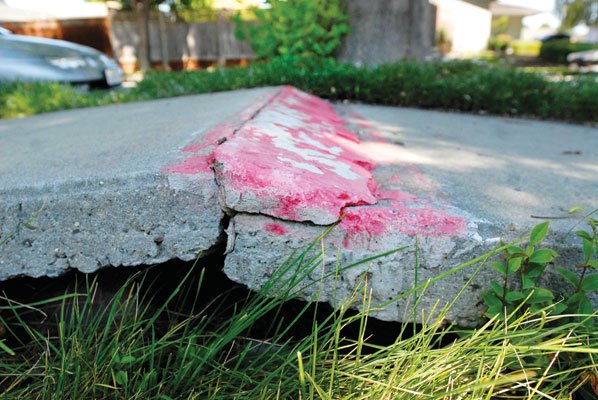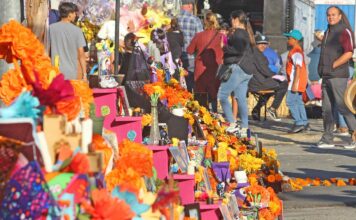Last week the city council agreed to pay $35,000 to settle a
personal injury lawsuit stemming from a broken sidewalk, adding
pressure to the body as it continues to consider how much it will
pay to fix the city’s cracked walkways.
Last week the city council agreed to pay $35,000 to settle a personal injury lawsuit stemming from a broken sidewalk, adding pressure to the body as it continues to consider how much it will pay to fix the city’s cracked walkways.
The council was scheduled to debate the issue Monday night after hearing earlier this month that Gilroy just doesn’t have the $7 million to $11 million it will cost to fix all the broken sidewalks across town. Councilman Bob Dillon has said he wants to take $3.7 million from the city’s dwindling reserves to fix the controversial problem, but the lawsuit added another financial headache for council members to consider.
“With all the things going on with sidewalks, it’s like, ‘Great, now this?’ ” Councilman Dion Bracco said last week after the city settled an 18-month-old lawsuit filed by Diane Nuno.
“We’re a target just like any business. People will sue you over anything,” Bracco said, adding that lawsuits like Nuno’s hit Gilroy because “homeowners pass on their personal responsibility” to fix their sidewalks. That, and “trial attorneys knowing the limit before it’s worthwhile for us to go to court. It comes to us, and it’s basically, ‘Pay up or risk losing a lot.'”
Nuno, 64, lost some mobility after she fell and injured her left wrist and thumb outside of Todd and Ginger Jackson’s home along Eighth Street in February, 2006. She tripped on a crack caused by one of two city trees between the Jackson’s sidewalk and the curb outside their house. Nuno required surgery and physical therapy, and the incident has aggravated her arthritis, according to her personal injury attorney, Philip Tobin.
“All this certainly makes life a lot more complicated when you’re in your mid 60s,” Tobin said. “The sidewalks are pretty notorious in Gilroy … And with my client, it was pretty well established that a tree caused the problem, and it was a city tree and a city problem.”
But no trees stand in the Jackson’s front yard anymore. Just a bright white ribbon of level concrete and a strip of sandy gravel. Todd Jackson repaired and replaced the entire sidewalk area and removed the trees and then split the cost with the city after the incident, he said. That runs most residents about $5,000, according to city figures. Of course, that’s on top of the $5,000 the Jacksons’ insurer, State Farm Insurance, agreed to pay Nuno, along with the $35,000 she and her attorney will receive from the city’s insurer, the Association of Bay Area Governments.
Despite the financial hit, Todd Jackson’s microcosm of an experience is just something he has resigned himself to.
“It’s water under the bridge. I don’t worry about it or think about it anymore,” Todd Jackson said with a half smile as he stood in his doorway Monday morning. “It’s behind me.”
He declined to talk about the settlement in depth, but did mention that his home insurance premium has not increased. The State Farm claim inspector involved in the settlement could not be reach for comment.
Still, the Jacksons’ case illustrates the vulnerability home owners with broken sidewalks face, along with the city, which is something the council tried to clarify last year with a now-dead ordinance that highlighted residents’ responsibility to repair sidewalks and assume partial liability for injuries sustained on them. But section 5610 of the state’s Streets and Highway Code conditioned such maintenance on the absence of any city-ordained entity causing the damage. A city-ordained entity such as a tree, Councilman Perry Woodward and some of his colleagues have said.
“What we’re finding out now is when someone slips and falls on one of these ill-maintained sidewalks, the city is on the hook,” Woodward said. “When people say we can’t afford to fix sidewalks, well we can’t afford not to fix them. We’ve been fortunate so far with not encountering a much worse situation.”
Woodward worked with council members Bob Dillon, Cat Tucker and Craig Gartman – all of whom campaigned against residential responsibility for damaged sidewalks last year – to kill the ordinance by stressing, like Tobin, that city-mandated trees tear up sidewalks.
Speaking about the city’s much larger share in the settlement payment and how an ordinance governing liability could have affected that number, Tobin said, “Somebody had to be responsible for the sidewalks, and if the city was somehow immune, then we would have had some difficulties, but there are certain ways to get around immunities.”
While the city never sought absolute immunity, voters disliked the idea of the city shifting, or even stressing, any legal responsibility they bore, something Woodward took advantage of during his campaign.
“The timing of this settlement highlights the fact that the city is responsible, which is what I was saying last year during campaign, and ever since,” Woodward said.
Nuno did not return messages for comment, but Tobin, who said he has litigated personal injury cases throughout the Bay Area, described the outcome of Nuno’s arbitrated settlement in mixed terms.
“It was a fair result, but it could’ve always been more fair,” he said with a chuckle. “All things considered, would she go through this again for $40,000? No, nobody would.”














